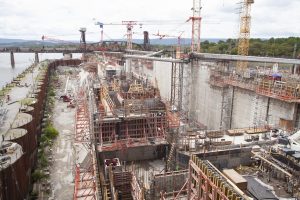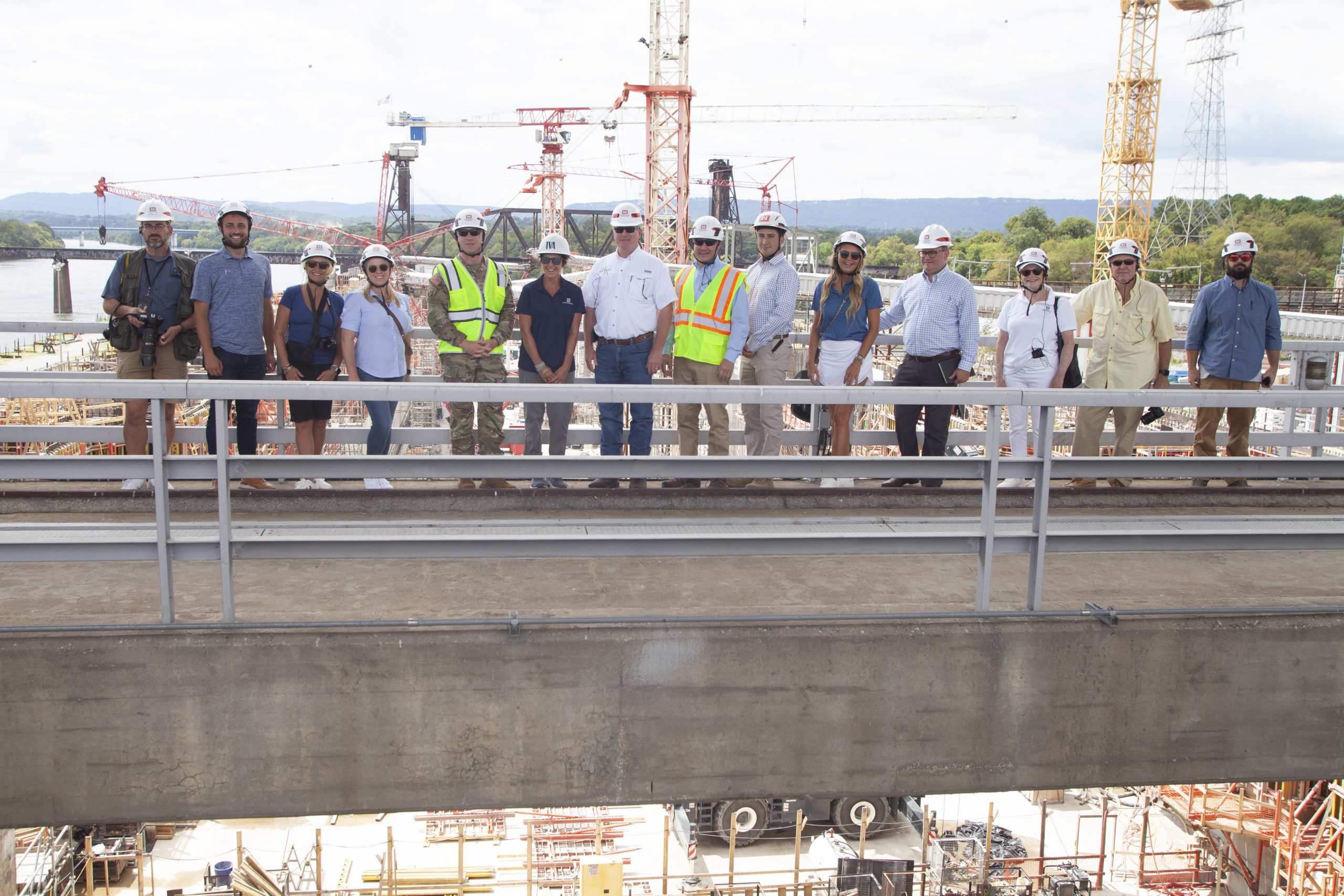Representatives from national publications and Chattanooga, Tenn., media outlets gathered at Chickamauga Lock at Mile 471 of the Tennessee River August 19 both to tour the old lock, which opened in 1940, and view the new lock, currently scheduled to open to navigation toward the end of 2027. The event was part of an infrastructure tour hosted annually by Waterways Council Inc. (WCI), in partnership with a Corps of Engineers district.
The old and new locks were quite a contrast. The old lock is riddled with a spiderweb of cracks due to alkali-aggregate reactions in the concrete, also known as concrete growth. Aggregate material for the original lock, which was sourced from the Chattanooga area, contains a high level of silica, which reacts with the alkali in the cement. That reaction causes the concrete to swell with a white, gel-like substance. leading to cracks and instability.
Corps of Engineers officials began noticing the concrete growth within two years of the lock opening in 1940. Since then, the Corps has employed a variety of strategies to mitigate the concrete growth, which has caused the 360-foot-long by 60-foot-wide lock to grow in length by a foot and in height by 4 inches. Occasionally, engineers will cut a slit in the lock wall, which relieves the pressure from the concrete growth. In addition, a vast array of post-tension rods and wires have been added over the years.
“That’s keeping everything the way it is,” said Paul Weaver, lockmaster of Chickamauga Lock.
The Corps has also added some 3,000 monitoring devices to track—and address—new movement in the structure.

Besides the structural issues at Chickamauga, its size is the big challenge for industry. At only 60 feet wide and 360 feet long, a typical nine-barge tow takes as much as 15 hours to trip through the existing lock. Despite those delays, tonnage moving through Chickamauga is on the rise. Last year, 1.3 million tons of cargo transited the lock, not counting products moved by government agencies. This year, the lock is on pace for 1.5 million tons.
“We take a lot of traffic off the road,” said Joe Cotton, project manager of the Chickamauga Lock replacement. “It’s more efficient.”
Unlike some lock construction projects on the inland waterways, the Corps will not retain the original lock at Chickamauga as an alternative or secondary chamber. Instead, the chamber will be filled with material removed to make way for the new chamber.
In contrast to the old lock, the new chamber at Chickamauga is new-concrete gray and a bustle of construction. The new lock chamber will measure 110 feet by 600 feet, which will drastically improve transit times.
“With this new lock, we’ll reduce passage times by up to 80 percent and enhance the working conditions of the mariners that rely on it,” said Jesse Davis, deputy commander of the Nashville Engineer District and a participant in the media tour.
Jen Armstrong, director of government relations for WCI, told media tour participants that investments in waterway infrastructure, like the new lock at Chickamauga, have direct impacts on the economy and the nation as a whole.
“For every dollar that gets invested in the Corps’ civil works budget, there’s a $14 return on investment and $7 back into the federal treasury,” Armstrong said.
With the lock replacement project, the Corps sourced aggregate from a different location to ensure alkali-aggregate reaction does not occur at the new lock.
During the tour, Corps officials emphasized the significance of the Chickamauga Lock Replacement Project, which extends beyond the benefits of commercial navigation all the way to Knoxville, Tenn. A stable, reliable lock helps maintain the pool in Chickamauga Lake, which provides cooling water to nearby power plants and drinking water to municipalities. There are also the flood management benefits.
At the work site, a sprawling conveyor system brings concrete in from a nearby batch plant. In all, the new lock will involve the placement of 255,000 cubic yards of concrete, enough concrete to lay a new road from Chattanooga to Nashville and back. Shimmick Construction Company is the prime contractor for the new 110- by 600-foot lock chamber. C.J. Mahan Construction Company is building the upstream approach walls. Previously, C.J. Mahan was the prime contractor on the cofferdam in which the new lock chamber is being constructed.
Construction of the new lock will also involve demolishing a portion of the dam and removing the spillway gates to make way for the new lock approach. With the dam also experiencing the same alkali-aggregate reaction as the old lock, the Corps will have to install a “sheer wall,” which will transfer the force of the concrete growth from one side of the new lock, under the new approach, and to the other side, thus maintaining the stability of the dam.
Throughout the process, the Corps intends to keep navigation open at Chickamauga.
“We are committed to having a lock operational at all times,” Cotton said.
The lock replacement project was authorized in 2003, with roadwork and bridge relocations beginning in 2005. Work on the new lock chamber started in 2017. Now fully funded, thanks to a $237 million earmark in the fiscal year 2024 Energy & Water Appropriations Bill, the earliest operational date for the new lock is November 2027. The earliest completion date, at present, is December 2029.
“The Chickamauga lock replacement has been a priority navigation project, and so it is gratifying to see such progress being made on the last phase of construction toward a 2027 operational date,” said Deb Calhoun, senior vice president of WCI.




